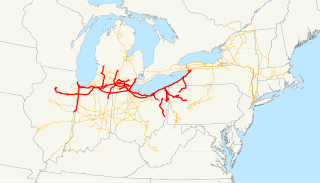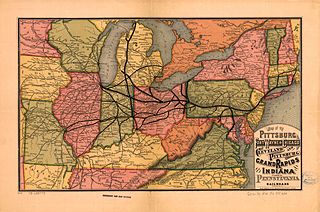Related Research Articles
The Toledo War (1835–36), also known as the Michigan–Ohio War, was an almost bloodless boundary dispute between the U.S. state of Ohio and the adjoining territory of Michigan.

Monroe is the largest city and county seat of Monroe County in the U.S. state of Michigan. Monroe had a population of 20,733 in the 2010 census. Located on the western shores of Lake Erie, the city is bordered on the south by Monroe Charter Township, but the two are administered autonomously. Monroe is located approximately 14 miles (23 km) north of Toledo, Ohio and 25 miles (40 km) south of Detroit. The U.S. Census Bureau lists Monroe as the core city in the Monroe Metropolitan Statistical Area, which is conterminous with Monroe County and had a population of 152,021 in 2010. Monroe is officially part of the Detroit–Ann Arbor–Flint combined statistical area.

The Detroit, Toledo and Ironton Railroad operated from 1905 to 1983 between its namesake cities of Detroit, Michigan, and Ironton, Ohio, via Toledo. At the end of 1970, it operated 478 miles of road on 762 miles of track; that year it carried 1,244 million ton-miles of revenue freight.

The Lake Shore and Michigan Southern Railway, established in 1833 and sometimes referred to as the Lake Shore, was a major part of the New York Central Railroad's Water Level Route from Buffalo, New York, to Chicago, Illinois, primarily along the south shore of Lake Erie and across northern Indiana. The line's trackage is still used as a major rail transportation corridor and hosts Amtrak passenger trains, with the ownership in 1998 split at Cleveland between CSX to the east, and Norfolk Southern in the west.

The Ann Arbor Railroad was an American railroad that operated between Toledo, Ohio, and Elberta and Frankfort, Michigan with train ferry operations across Lake Michigan. In 1967 it reported 572 million net ton-miles of revenue freight, including 107 million in "lake transfer service"; that total does not include the 39-mile subsidiary Manistique and Lake Superior Railroad.

The Detroit and Toledo Shore Line Railroad is a historic railroad that operated in northwestern Ohio and southeastern Michigan.
The Detroit Line is a freight railroad line owned and operated by the Norfolk Southern Railway in the U.S. states of Michigan and Ohio.
The Flint and Pere Marquette Railroad (F&PM) is a defunct railroad which operated in the U.S. state of Michigan between 1857 and 1899. It was one of the three companies which merged to become the Pere Marquette Railway.
The Detroit, Lansing and Northern Railroad (DL&N) is a defunct railroad which was formed on December 27, 1876 as a reorganization of the foreclosed Detroit, Lansing and Lake Michigan Rail Road. The segment of its main line from Detroit to Lansing became an important component of the Pere Marquette Railroad, organized in 1900, and is still in use by CSX.
The Manistee Railroad in Michigan was a wholly owned subsidiary of the Flint and Pere Marquette Railroad (F&PM). It was established on June 19, 1880, to construct a branch line from the F&PM's main line (Ludington–Monroe) at Walhalla to Manistee. The completion of this line in 1883 gave the F&PM access to Manistee's lake trade and local salt mining operations. The Manistee Railroad was consolidated with the F&PM on January 30, 1889.
The Chicago and West Michigan Railway (C&WM) is a defunct railroad which operated in the state of Michigan between 1881 and 1899. It was one of the three companies which merged to become the Pere Marquette Railway.
The Paw Paw Railroad is a defunct railroad which operated in Van Buren County, Michigan, between 1857 and 1887. At a length of 4 miles (6.4 km), it was the shortest operating common carrier railroad in the state. Later, the Ludington & Northern Railway Company, at 2.79 miles (4.49 km), stripped the Paw Paw of its title as "shortest Michigan Railroad".
The White River Railroad was a wholly owned subsidiary of the Chicago and West Michigan Railroad incorporated on November 13, 1879, for the purpose of constructing a rail link north from the C&WM's line at White Cloud to the Flint and Pere Marquette Railroad's main line (Ludington–Monroe) at Baldwin, and to exploit the ample timber resources of the White River area. On April 1, 1880, the White River opened a 13-mile (21 km) line from White Cloud north to Merrill Township, in Newaygo County. In 1881 the line was extended a further 4 miles (6.4 km) to what would become Bitely in 1889. In either late 1883 or no later than February 7, 1884, the White River completed the line all the way to Baldwin, for a total length of 29.86 miles (48.06 km).

The Mansfield, Coldwater and Lake Michigan Railroad (MCW&LM) is a defunct railroad which operated in southern Michigan and Ohio during the 1870s. By the time it went into foreclosure in the late 1870s it owned two non-contiguous track segments, each of which was leased by a different company.
The above shows the physical line of the Michigan and Ohio as of March 25, 1887, when the Cincinnati, Jackson & Mackinaw bought it, including crossings by other lines as they were then constituted. Intermediate stations omitted. The Michigan and Ohio Railroad is a defunct railroad which operated in southern Michigan in the mid-1880s. Originally intended to forge a new line from Lake Erie to Lake Michigan, it came close to its goal, completing a line between Allegan and Dundee before financial embarrassment landed it in receivership.
The Michigan Railroad Commission was an agency in the state of Michigan which regulated the operations of railroads within the state. It was established by the Michigan Legislature in 1873; in 1919 it was abolished and its functions transferred to a new body, the Michigan Public Utilities Commission.

The Hocking Valley Railway was a railroad in the U.S. state of Ohio, with a main line from Toledo to Athens and Pomeroy via Columbus. It also had several branches to the coal mines of the Hocking Valley near Athens. The company became part of the Chesapeake and Ohio Railway system in 1910, and the line between Toledo and Columbus continues to see trains as CSX Transportation's Columbus Subdivision. Portions of the main line south of Columbus are now operated by the Indiana and Ohio Railway and Hocking Valley Scenic Railway.

The Cincinnati Northern Railroad was a railroad that stretched from Franklin, Ohio north to Jackson, Michigan, a distance of about 186 miles (299 km). It was acquired by the Cleveland, Cincinnati, Chicago and St. Louis Railway in 1901 and the New York Central Railroad several years later. Most of the line has since been abandoned.

The Detroit, Monroe and Toledo Railroad (DM&T) was a shortline railroad which operated in the U.S. states of Michigan and Ohio. Opened in 1856, its main line ran from Detroit, Michigan, to Toledo, Ohio. The railroad leased itself to the Michigan Southern and Northern Indiana Railroad (MS&NI) in 1856. A 1914 merger which created the New York Central Railroad led to the DM&T's consolidation into the new road, ending its existence.
References
- Michigan Railroad Commission (1893). Annual Report.
- Michigan Railroad Commission (1899). Annual Report.
| This United States railway company-related article is a stub. You can help Wikipedia by expanding it. |